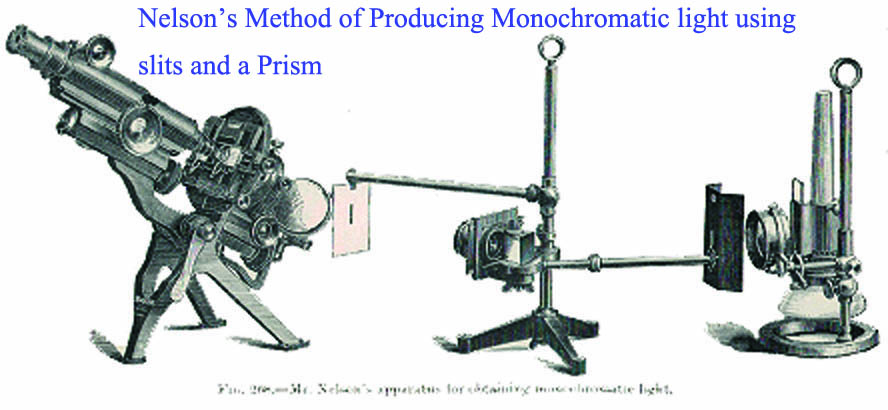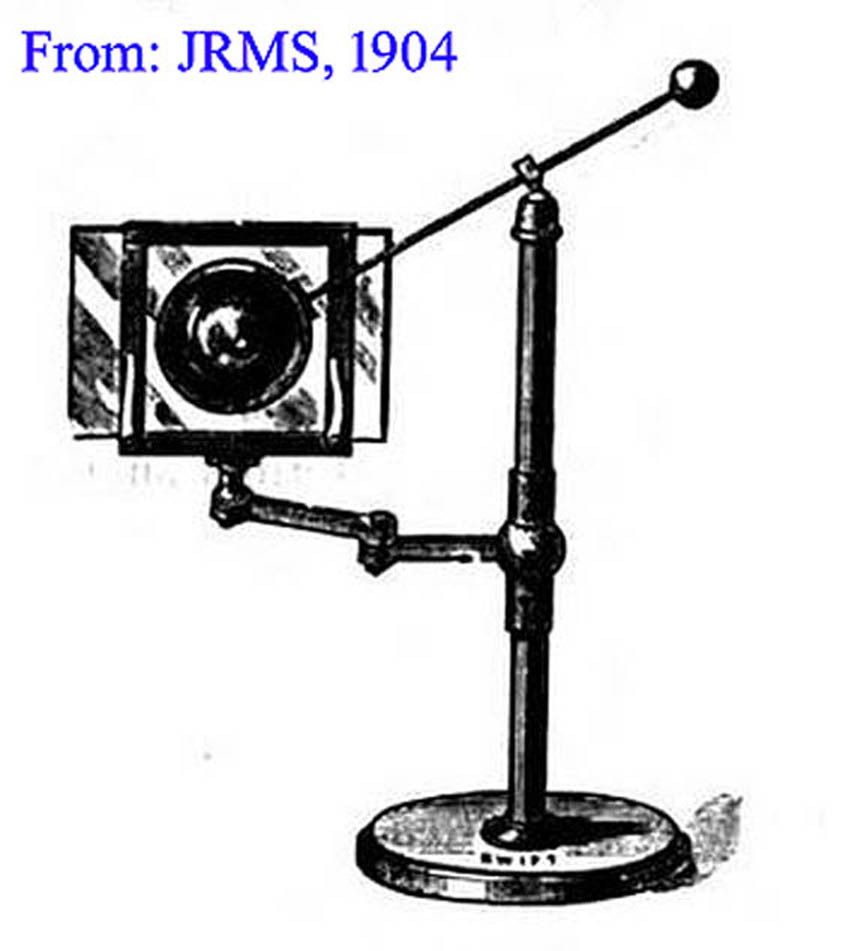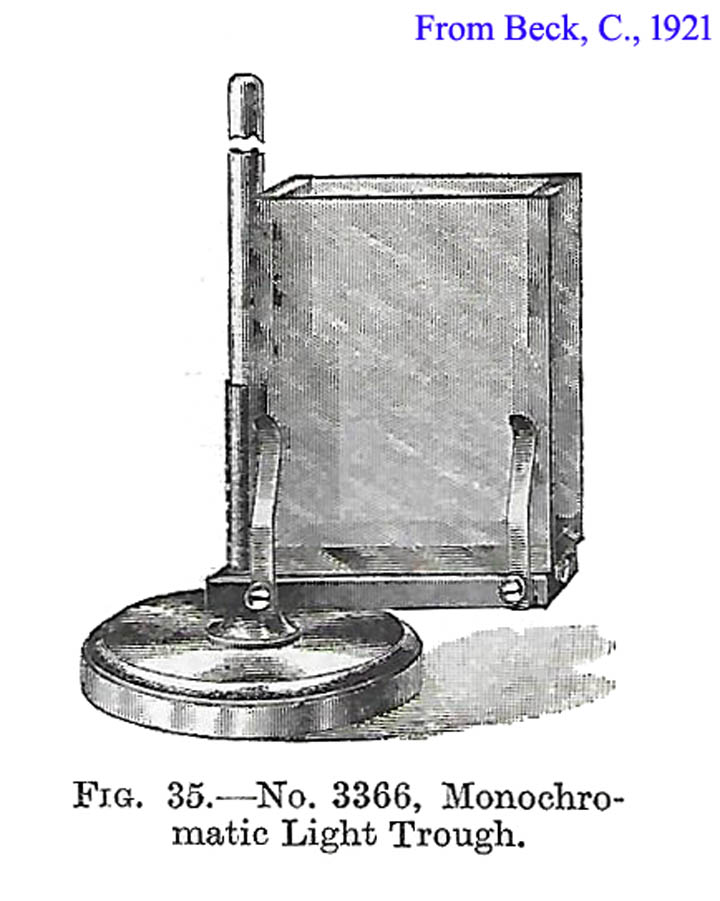FILTER HOLDER AND BULLSEYE CONDENSER ON STAND
c. 1900
Attributed to: JAMES SWIFT & SON
MODEL: 'LIGHT MODIFIER'
Offered from 1892 through at least 1913
Please Click On Any Picture for a Larger Version
DESCRIPTION:
The apparatus consists of a lead-filled lacquered brass base (diameter about 3 inches-25.4 mm), upon which a straight pillar is erected. The top of the ball joint at the top of the pillar is about 9 inches(22.9 mm), above the bottom of the base. Between the top and bottom of this pillar slides a T-shaped support. This support is similar to ones used by Beck for support of their large bullseye condensers, but this one supports the articulating arm for the screen's rectangular frame which measures 61 x 58 mm (2.4 x 2.3 inches). The shelf at the bottom of this frame is about 1/4 inch in depth, limiting the practical size of the accessories it can carry to this thickness. Pressing on to the frame are two large spring clips, much like stage clips, but vertically oriented against the frame. Their size and shape allows the support of either a thin piece of glass, or a thicker, i.e 1/4 inch thick, fluid-filled trough. The bullseye and the filter can then be used together to direct a concentrated, yet filtered source of light, into the microscope. At the top of the pillar is a ball joint supporting the bullseye condenser. With the various adjustments, it is easy to direct light concentrated by the bullseye through the 'screen' of either colored glass, glass over gelatin, or liquid in a trough.
HISTORY OF 'LIGHT MODIFIERS' AND THE 'GIFFORD SCREEN APPARATUS':
As photomicrography was refined in the late 19th century, it was noted that to obtain the sharpest image on film, monochromatic light was most helpful. This is because achromatic aplanatic objectives are not fully corrected for all colors and so some degree of chromatic aberration will result in an image which is not perfectly sharp; this effect becomes even more evident in a photograph. For this reason, various methods of creating a relatively monochromatic light source were developed. One method was to use light coming from a burning chemical. This obviously has many drawbacks. A second method, which was very expensive and tedious to set up, was to use a prism to break up light into its component colors and then use only the portion desired. The second method has the disadvantage of producing a very small field with only one color and in addition the field was not homogeneous as the color is changing slightly from side to side. To partially overcome some of the drawbacks of this method, Nelson devised an apparatus in which light initially passed through a slit then through the prism, and then again through another slit. This apparatus of Nelson's from the 1901 edition of the Microscope and its Revelations by Dallinger is shown below:

 Lastly, and most practically was the use of a filter. Various filters were developed and the commonest was simply to use colored glass. This is the main use for which the apparatus by Swift, shown at the top of this page, and in the Swift Catalog Entries for 1892 and 1906 would be used. This model includes the convenience of an integrated bullseye condenser on a separate arm. Although offered in the Swift catalog of 1892, Swift's apparatus was not reported in the JRMS until 1904, pages 110-111. The catalogs of Swift continued to offer this apparatus through at least 1913. This apparatus was not intended to take a trough, though a very thin one, as in a Gifford screen apparatus(see below), can be used with it.
Lastly, and most practically was the use of a filter. Various filters were developed and the commonest was simply to use colored glass. This is the main use for which the apparatus by Swift, shown at the top of this page, and in the Swift Catalog Entries for 1892 and 1906 would be used. This model includes the convenience of an integrated bullseye condenser on a separate arm. Although offered in the Swift catalog of 1892, Swift's apparatus was not reported in the JRMS until 1904, pages 110-111. The catalogs of Swift continued to offer this apparatus through at least 1913. This apparatus was not intended to take a trough, though a very thin one, as in a Gifford screen apparatus(see below), can be used with it.

 The disadvantage of colored glass is that in order to filter sufficiently it had to be rather dense and hence the brightness of the light suffered greatly. In 1894 Gifford published an article in the transactions of the Royal microscopical Society in which he discussed the advantages of gelatin filters, solid glass filters and a trough filled with colored liquid. He supplied a formula using malachite green, glycerin, and picric acid which produced a nearly pure blue green light without the degree of loss of brightness inherent in plain colored glass. This was, at the time, a good match for the film that he was using. At other times, other colors such as yellow filters were used as different emulsions have different peak sensitivities. What became known as 'Gifford's Screen' consisted of a stand with a holder for either a piece of colored glass, a sandwich of gelatin between two pieces of glass, or his alternative method of a glass trough filled with colored liquid. These holders could accomodate either type of filter. Both the article by Gifford and the
section on monochromatic illumination in the 1901 edition of Carpenter's
The disadvantage of colored glass is that in order to filter sufficiently it had to be rather dense and hence the brightness of the light suffered greatly. In 1894 Gifford published an article in the transactions of the Royal microscopical Society in which he discussed the advantages of gelatin filters, solid glass filters and a trough filled with colored liquid. He supplied a formula using malachite green, glycerin, and picric acid which produced a nearly pure blue green light without the degree of loss of brightness inherent in plain colored glass. This was, at the time, a good match for the film that he was using. At other times, other colors such as yellow filters were used as different emulsions have different peak sensitivities. What became known as 'Gifford's Screen' consisted of a stand with a holder for either a piece of colored glass, a sandwich of gelatin between two pieces of glass, or his alternative method of a glass trough filled with colored liquid. These holders could accomodate either type of filter. Both the article by Gifford and the
section on monochromatic illumination in the 1901 edition of Carpenter's The Microscope and its Revelations,
by Dallinger, mentions that the colored solution does not quite produce a pure monochromatic light and to do this a thin piece of green glass is placed inside the trough along with the solution or between the light source and the trough.

 Lastly, and most practically was the use of a filter. Various filters were developed and the commonest was simply to use colored glass. This is the main use for which the apparatus by Swift, shown at the top of this page, and in the Swift Catalog Entries for 1892 and 1906 would be used. This model includes the convenience of an integrated bullseye condenser on a separate arm. Although offered in the Swift catalog of 1892, Swift's apparatus was not reported in the JRMS until 1904, pages 110-111. The catalogs of Swift continued to offer this apparatus through at least 1913. This apparatus was not intended to take a trough, though a very thin one, as in a Gifford screen apparatus(see below), can be used with it.
Lastly, and most practically was the use of a filter. Various filters were developed and the commonest was simply to use colored glass. This is the main use for which the apparatus by Swift, shown at the top of this page, and in the Swift Catalog Entries for 1892 and 1906 would be used. This model includes the convenience of an integrated bullseye condenser on a separate arm. Although offered in the Swift catalog of 1892, Swift's apparatus was not reported in the JRMS until 1904, pages 110-111. The catalogs of Swift continued to offer this apparatus through at least 1913. This apparatus was not intended to take a trough, though a very thin one, as in a Gifford screen apparatus(see below), can be used with it.
 The disadvantage of colored glass is that in order to filter sufficiently it had to be rather dense and hence the brightness of the light suffered greatly. In 1894 Gifford published an article in the transactions of the Royal microscopical Society in which he discussed the advantages of gelatin filters, solid glass filters and a trough filled with colored liquid. He supplied a formula using malachite green, glycerin, and picric acid which produced a nearly pure blue green light without the degree of loss of brightness inherent in plain colored glass. This was, at the time, a good match for the film that he was using. At other times, other colors such as yellow filters were used as different emulsions have different peak sensitivities. What became known as 'Gifford's Screen' consisted of a stand with a holder for either a piece of colored glass, a sandwich of gelatin between two pieces of glass, or his alternative method of a glass trough filled with colored liquid. These holders could accomodate either type of filter. Both the article by Gifford and the
section on monochromatic illumination in the 1901 edition of Carpenter's
The disadvantage of colored glass is that in order to filter sufficiently it had to be rather dense and hence the brightness of the light suffered greatly. In 1894 Gifford published an article in the transactions of the Royal microscopical Society in which he discussed the advantages of gelatin filters, solid glass filters and a trough filled with colored liquid. He supplied a formula using malachite green, glycerin, and picric acid which produced a nearly pure blue green light without the degree of loss of brightness inherent in plain colored glass. This was, at the time, a good match for the film that he was using. At other times, other colors such as yellow filters were used as different emulsions have different peak sensitivities. What became known as 'Gifford's Screen' consisted of a stand with a holder for either a piece of colored glass, a sandwich of gelatin between two pieces of glass, or his alternative method of a glass trough filled with colored liquid. These holders could accomodate either type of filter. Both the article by Gifford and the
section on monochromatic illumination in the 1901 edition of Carpenter's